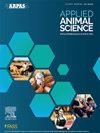Culture- and polymerase chain reaction–based prevalence of bacterial pathogens in liver abscesses and ruminal wall tissues of beef-on-dairy feedlot cattle fed finishing diets with no additives, tylosin, or antibiotic alternatives to control liver abscesses*
IF 1.5
Q3 AGRICULTURE, DAIRY & ANIMAL SCIENCE
引用次数: 0
Abstract
Objective
Our objectives were to investigate the prevalence and concentrations of major bacterial pathogens associated with liver abscesses and ruminal epithelial tissues of beef-on-dairy heifers fed finishing diets containing no additives (negative control), tylosin, or a probiotic (yeast) and zeolite combination to control liver abscesses.
Materials and Methods
A total of 74 liver abscesses and 69 ruminal epithelial tissues, collected at slaughter, were subjected to culture-based methods to isolate 5 bacterial species, Fusobacterium necrophorum ssp. necrophorum, F. necrophorum ssp. funduliforme, Trueperella pyogenes, Salmonella enterica, and Escherichia coli, and to a quantitative PCR (qPCR) assay to determine prevalence and concentrations of the 2 F. necrophorum subspecies. Statistical analyses included Fisher’s exact test for prevalence and ANOVA for bacterial concentrations to compare the treatment groups.
Results and Discussion
Both culture method and qPCR assay indicated that the ssp. necrophorum was the dominant pathogen, and the prevalence tended to be greater in the negative control group than in the tylosin or yeast-plus-zeolite groups. The prevalence of ssp. funduliforme was not different between the treatment groups. Concentrations of both subspecies were in log 6 to 7 cfu/g and were not affected by treatment. The prevalence of T. pyogenes and S. enterica were low, but the prevalence of E. coli was high. A total of 5 liver abscesses were negative for both subspecies, suggesting that 6% of abscesses were caused by pathogens other than F. necrophorum. In ruminal tissues, the prevalence of ssp. funduliforme was greater than the ssp. necrophorum.
Implications and Applications
The combination of culture method and qPCR assay provided complementary assessment of the prevalence of the major pathogens in liver abscesses of beef-on-dairy cattle, which was similar to that of liver abscesses in cattle of beef breeds. This is the first study that used a qPCR assay to detect and quantify the 2 subspecies of F. necrophorum in liver abscesses.
以培养和聚合酶链反应为基础,研究饲喂育肥牛的肝脏脓肿和瘤胃壁组织中细菌病原体的患病率,这些牛饲喂不添加添加剂、泰络菌素或抗生素替代品来控制肝脏脓肿*
我们的目的是调查与肝脓肿和瘤胃上皮组织相关的主要细菌病原体的患病率和浓度,在饲喂不含添加剂(阴性对照)、泰乐蛋白或益生菌(酵母)和沸石组合的育肥牛饲粮中,以控制肝脓肿。材料与方法对屠宰时收集的74个肝脓肿和69个瘤胃上皮组织进行培养,分离出坏死梭杆菌5种细菌。necrophorum;真菌、化脓性真杆菌、肠炎沙门氏菌和大肠杆菌,以及定量PCR (qPCR)测定2种坏死菌亚种的流行率和浓度。统计分析包括Fisher的流行率精确检验和细菌浓度方差分析来比较治疗组。结果与讨论培养法和qPCR检测均表明:Necrophorum为优势病原菌,阴性对照组的患病率高于tylosin或酵母+沸石组。ssp的流行。各组间眼底成形无明显差异。两个亚种的浓度都在6 ~ 7 cfu/g之间,不受处理的影响。化脓性乳杆菌和肠链球菌的流行率较低,而大肠杆菌的流行率较高。共有5例肝脓肿在两个亚种中均呈阴性,表明6%的肝脓肿是由坏死芽孢杆菌以外的病原体引起的。在瘤胃组织中,ssp的患病率。基底形成大于ssp。necrophorum。意义与应用培养法与qPCR法相结合,对奶牛肝脓肿中主要病原菌的流行情况进行了补充评估,结果与肉牛肝脓肿的流行情况相似。这是首次使用qPCR检测和定量肝脓肿中坏死孢子虫的2个亚种的研究。
本文章由计算机程序翻译,如有差异,请以英文原文为准。
求助全文
约1分钟内获得全文
求助全文

 求助内容:
求助内容: 应助结果提醒方式:
应助结果提醒方式:


